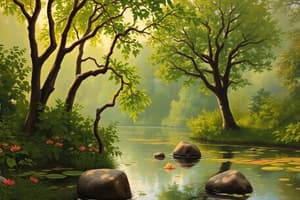Podcast
Questions and Answers
What percentage of Earth's surface do freshwater ecosystems cover?
What percentage of Earth's surface do freshwater ecosystems cover?
- 5.5 percent
- 1.8 percent (correct)
- 10.2 percent
- 15.3 percent
What do organisms in an ecosystem primarily compete for?
What do organisms in an ecosystem primarily compete for?
- Physical appearance
- Genetic diversity
- Limited resources (correct)
- Social interaction
Which type of ecosystem is the most common on Earth?
Which type of ecosystem is the most common on Earth?
- Freshwater
- Wetland
- Marine (correct)
- Terrestrial
Which of the following factors significantly influences community dynamics in an ecosystem?
Which of the following factors significantly influences community dynamics in an ecosystem?
What is one of the primary roles of phytoplankton in the ocean?
What is one of the primary roles of phytoplankton in the ocean?
What type of ecosystem is characterized by biodiversity found in coral reefs?
What type of ecosystem is characterized by biodiversity found in coral reefs?
Which category of ecosystems includes biomes?
Which category of ecosystems includes biomes?
Which of the following is NOT a component of freshwater ecosystems?
Which of the following is NOT a component of freshwater ecosystems?
What defines the apex consumer in a food chain?
What defines the apex consumer in a food chain?
Why is energy loss significant in a food chain?
Why is energy loss significant in a food chain?
Which organisms are referred to as primary consumers in a food chain?
Which organisms are referred to as primary consumers in a food chain?
What is the role of decomposers in an ecosystem?
What is the role of decomposers in an ecosystem?
In the typical structure of a food chain, what is the foundation composed of?
In the typical structure of a food chain, what is the foundation composed of?
What happens to energy as it moves through the trophic levels of a food chain?
What happens to energy as it moves through the trophic levels of a food chain?
What is typically the highest level of consumer in a food web?
What is typically the highest level of consumer in a food web?
How does the resilience of an ecosystem relate to energy flow?
How does the resilience of an ecosystem relate to energy flow?
What is the primary concern associated with the biomagnification of substances in aquatic ecosystems?
What is the primary concern associated with the biomagnification of substances in aquatic ecosystems?
Which fish types are recommended for pregnant individuals and young children due to their low mercury content?
Which fish types are recommended for pregnant individuals and young children due to their low mercury content?
What happens to energy as it flows through an ecosystem?
What happens to energy as it flows through an ecosystem?
What type of organisms are primarily studied in relation to the accumulation of PCBs in aquatic ecosystems?
What type of organisms are primarily studied in relation to the accumulation of PCBs in aquatic ecosystems?
Which of the following substances is NOT specifically mentioned as undergoing biomagnification in aquatic ecosystems?
Which of the following substances is NOT specifically mentioned as undergoing biomagnification in aquatic ecosystems?
How do human activities impact the biogeochemical cycles discussed in the document?
How do human activities impact the biogeochemical cycles discussed in the document?
What is an effect of biomagnification on organisms at higher trophic levels?
What is an effect of biomagnification on organisms at higher trophic levels?
Which of these elements is NOT one of the biogeochemical cycles mentioned?
Which of these elements is NOT one of the biogeochemical cycles mentioned?
What is the primary role of decomposers in a detrital food web?
What is the primary role of decomposers in a detrital food web?
Which statement accurately describes the relationship between grazing and detrital food webs?
Which statement accurately describes the relationship between grazing and detrital food webs?
What is the primary function of autotrophs in an ecosystem?
What is the primary function of autotrophs in an ecosystem?
What type of organisms primarily make up the base of a grazing food web?
What type of organisms primarily make up the base of a grazing food web?
What type of energy do photoautotrophs primarily harness?
What type of energy do photoautotrophs primarily harness?
How is gross primary productivity defined?
How is gross primary productivity defined?
What role do chemoautotrophs play in the hydrothermal vent ecosystem?
What role do chemoautotrophs play in the hydrothermal vent ecosystem?
In a meadow ecosystem, what would primarily feed on dead organisms?
In a meadow ecosystem, what would primarily feed on dead organisms?
What is biomagnification?
What is biomagnification?
Which of the following correctly describes a detritivore?
Which of the following correctly describes a detritivore?
What does net primary productivity account for in producers?
What does net primary productivity account for in producers?
What are chemoautotrophs known for?
What are chemoautotrophs known for?
What form of energy do most living organisms primarily utilize during metabolism?
What form of energy do most living organisms primarily utilize during metabolism?
Which substance was primarily responsible for the fragility of eggshells in bald eagles?
Which substance was primarily responsible for the fragility of eggshells in bald eagles?
Which organisms serve as the primary energy source for the majority of ecosystems?
Which organisms serve as the primary energy source for the majority of ecosystems?
Why are substances that biomagnify stored in the fat reserves of organisms?
Why are substances that biomagnify stored in the fat reserves of organisms?
How do bacteria and fungi contribute to ecosystem health?
How do bacteria and fungi contribute to ecosystem health?
What was the significant impact of DDT on bird populations in aquatic ecosystems?
What was the significant impact of DDT on bird populations in aquatic ecosystems?
What is a key characteristic of a grazing food web?
What is a key characteristic of a grazing food web?
In what type of environment are chemoautotrophs typically found?
In what type of environment are chemoautotrophs typically found?
How does energy transfer through trophic levels in ecosystems relate to biomagnification?
How does energy transfer through trophic levels in ecosystems relate to biomagnification?
What role do food-web diagrams play in understanding ecosystems?
What role do food-web diagrams play in understanding ecosystems?
What feature of the hydrothermal vent ecosystem supports life in complete darkness?
What feature of the hydrothermal vent ecosystem supports life in complete darkness?
When was DDT banned in the United States due to its ecological impact?
When was DDT banned in the United States due to its ecological impact?
Flashcards
Ecosystem Categories
Ecosystem Categories
Ecosystems are broadly categorized into freshwater, marine, and terrestrial.
Ecosystem Competition
Ecosystem Competition
Organisms within an ecosystem compete for limited resources like food, water, and space.
Freshwater Ecosystems
Freshwater Ecosystems
The least common type, covering only 1.8% of Earth's surface, including lakes, rivers, streams, and springs.
Marine Ecosystems
Marine Ecosystems
Signup and view all the flashcards
Photosynthesis (Marine)
Photosynthesis (Marine)
Signup and view all the flashcards
Terrestrial Ecosystems
Terrestrial Ecosystems
Signup and view all the flashcards
Environmental Variables
Environmental Variables
Signup and view all the flashcards
Resource Competition
Resource Competition
Signup and view all the flashcards
Food Chain Structure
Food Chain Structure
Signup and view all the flashcards
Trophic Levels
Trophic Levels
Signup and view all the flashcards
Producers
Producers
Signup and view all the flashcards
Primary Consumers
Primary Consumers
Signup and view all the flashcards
Secondary Consumers
Secondary Consumers
Signup and view all the flashcards
Tertiary Consumers
Tertiary Consumers
Signup and view all the flashcards
Apex Consumers
Apex Consumers
Signup and view all the flashcards
Energy Loss in Food Chains
Energy Loss in Food Chains
Signup and view all the flashcards
Grazing Food Web
Grazing Food Web
Signup and view all the flashcards
Detrital Food Web
Detrital Food Web
Signup and view all the flashcards
Decomposers
Decomposers
Signup and view all the flashcards
Detritivores
Detritivores
Signup and view all the flashcards
Energy Flow in Ecosystems
Energy Flow in Ecosystems
Signup and view all the flashcards
Metabolic Pathways
Metabolic Pathways
Signup and view all the flashcards
ATP
ATP
Signup and view all the flashcards
Why do organisms need energy?
Why do organisms need energy?
Signup and view all the flashcards
Energy Input
Energy Input
Signup and view all the flashcards
Food Webs and Energy Flow
Food Webs and Energy Flow
Signup and view all the flashcards
Autotrophs: Energy Producers
Autotrophs: Energy Producers
Signup and view all the flashcards
Photoautotrophs: Harnessing Sunlight
Photoautotrophs: Harnessing Sunlight
Signup and view all the flashcards
Chemoautotrophs: Energy from Chemicals
Chemoautotrophs: Energy from Chemicals
Signup and view all the flashcards
Gross Primary Productivity
Gross Primary Productivity
Signup and view all the flashcards
Net Primary Productivity
Net Primary Productivity
Signup and view all the flashcards
Importance of Autotrophs
Importance of Autotrophs
Signup and view all the flashcards
Chemoautotrophs
Chemoautotrophs
Signup and view all the flashcards
Hydrothermal Vent Ecosystem
Hydrothermal Vent Ecosystem
Signup and view all the flashcards
Biological Magnification
Biological Magnification
Signup and view all the flashcards
DDT (Dichlorodiphenyltrichloroethane)
DDT (Dichlorodiphenyltrichloroethane)
Signup and view all the flashcards
PCB (Polychlorinated Biphenyls)
PCB (Polychlorinated Biphenyls)
Signup and view all the flashcards
Heavy Metals
Heavy Metals
Signup and view all the flashcards
Why are some substances more likely to biomagnify?
Why are some substances more likely to biomagnify?
Signup and view all the flashcards
Biomagnification
Biomagnification
Signup and view all the flashcards
PCB Concentration Increase
PCB Concentration Increase
Signup and view all the flashcards
Mercury in Seafood
Mercury in Seafood
Signup and view all the flashcards
Biogeochemical Cycles
Biogeochemical Cycles
Signup and view all the flashcards
Ecosystem Dynamics and Food
Ecosystem Dynamics and Food
Signup and view all the flashcards
Study Notes
Ecosystems and the Biosphere
- Ecosystem ecology is an extension of organismal, population, and community ecology
- Ecosystems include all biotic (living) and abiotic (non-living) components in an area
- Abiotic components include air, water, soil, and climate
- Ecosystem biologists study how nutrients and energy are transferred between organisms and their environment
- Wild lupine and Karner blue butterflies live in oak-pine barren habitats
- This habitat is characterized by natural disturbances (like fire) and nutrient-poor soils
Water's Energy Flow Through Ecosystems
- Ecosystems on Earth come in various categories (freshwater, marine, and terrestrial)
- Individual ecosystems differ based on environment and organisms
- Life in ecosystems often involves competition for resources (food, water, sunlight, space, minerals)
- These resources provide energy and matter for life processes
- Factors affecting community dynamics include climate, seasons, sunlight, rainfall, elevation, and geology
Biogeochemical Cycles
- Energy flows directionally through ecosystems, from sunlight to heat during transfer
- Matter in living organisms is conserved and recycled
- Biogeochemical cycles involve processes like weathering, erosion, water drainage, and subduction
- Water is crucial for all living processes; its movements are tracked by the hydrosphere
- Carbon, nitrogen, hydrogen, oxygen, phosphorus, and sulfur are crucial elements in organic molecules
- These elements recycle between biotic and abiotic parts of the biosphere
Studying That Suits You
Use AI to generate personalized quizzes and flashcards to suit your learning preferences.




